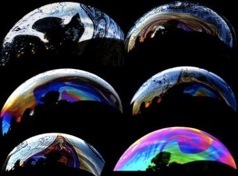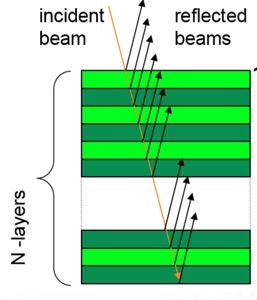The Giant Blue Morpho Butterfly (Morpho didius)
Take a look at the Blue Morpho butterfly. The Blue Morpho butterfly exhibits a brilliant, iridescent blue wing color. What does the underside of the butterfly look like? Do you think this color contributes to the blue color of the top of the wing?
View a brief movie showing the structure of the butterfly here.
Take the small flashlight and shine it on the bottom side of the wing. What color do you see from the top? Does this give you any indication as to the mechanism that produces the colors on either side of the wing?
The pigmented color of the wings of the Blue Morpho is brown. Since the top of the wing appears brown when illuminated from the back, the brilliant blue seen by the eye must be due to the structure of the wing, and not due to pigment. The brown scales do help contribute to the overall blue color by absorbing the non blue components of light.
What kind of structures could produce the iridescent blue color of the wings?


Take out the round silicon wafer and the small bottle of alcohol. Using the eyedropper put several drops of alcohol in the center of the silicon and spread it around in a puddle about two inches across. Look at the reflection of a nearby light in the alcohol and watch as it evaporates. Can you explain what you are seeing? Why are the colors changing? Why are the colors repeating?
When you first observed colors forming in the puddle that meant that the puddle was a small number of wavelengths of that color thick. As the puddle evaporated and became thinner the thickness periodically was just right to selectively reflect one color. The starting thickness was enough that the range of colors could be cycled through several times.
The Blue Morpho butterfly has 6-10 layers of branches that make up these tree like structures, resulting in multilayer that selectively reflects blue. Due to the number of cuticle branches on each tree and the specific spacing and thickness of the air and cuticle layers, a bright reflection of light and a vivid blue color are produced which would not be present with fewer layers or different thicknesses of those layers. We can’t easily change the layer thicknesses but we can change what one of those layers is made of.
Notice that the plastic box has a small hole in the top. Using the eyedropper, place a small drop of alcohol gently on the wing. Can you explain what you see? Why does the color change?
Recall that the color of light that is reflected is determined in part by the index of refraction of the layers. Here we have displaced the air and replaced it with alcohol, which has a higher index of refraction, so the reflected color shifts into the green.
Look at the butterfly from different angles. How does the Color change? Look at the Peacock Swallowtail the same way. How does it compare to the Blue Morpho?
The color of the Blue Morpho butterfly stays in the blue regardless of the viewing angle, while the color of the Peacock Swallowtail changes. We’ll look at the structure of the Peacock Swallowtail in the next section. The constant blue is in part due to a diffraction grating effect.
How is the structure of the Blue Morpho butterfly similar to a diffraction grating?
Structures on the scales of the wing of the Blue Morpho butterfly are tree-like in shape and are arranged in rows. The rows of these structures, act as a diffraction grating which in part causes the blue color.
Illuminate the wing with the green LED. What color do you see? What color do you see reflected with the red LED? Is this what you expected?
Conclusions:
The blue structural color is caused mainly from thin film interference due to the tree like structures on the scales.
The irregularity in the ridge height of the rows of tree like structures results in a diffuse and uniformly blue color with viewing angle.
The brightness of the color is due to the 6–10 layers of branches in each tree.
The pigment beneath each of these scale absorbs the unnecessary green to red light, which reduces the background reflection and enhances the blue structural color.
The “branches” on the “trees” are about 400 nm [4,400 S/D] long. Shinya Yoshioka, Osaka University
Typical Soap bubbles.

The diagram to the left models a single tree like scale of the Blue Morpho butterfly. The light green is the scale, made of cuticle, the dark green is air. The indices of refraction of the scales and the air, coupled with the thickness of each layer determine the color of light reflected, in this case blue. Ille C. Gebeshuber, 2009

